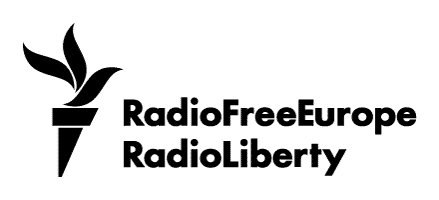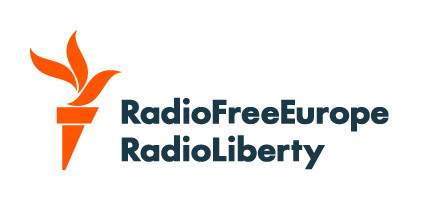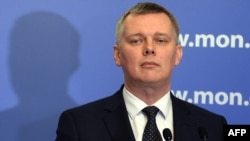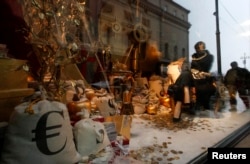Polish Defense Minister Tomasz Siemoniak to broadcaster TVN24 in Warsaw yesterday:
"Over the past few days we have seen unprecedented activity by the Russians in the Baltic Sea, both the Baltic fleet and Russian aircraft."
Siemoniak added that Poland, a member of NATO, is not under threat of attack and the Russian maneuvers are most likely designed to test how NATO forces in the region reacted.
Siemoniak also said Warsaw's decision to acquire long-range missiles from the United States was due on the current tensions in the region.
The $250 million deal includes 40 joint air-to-surface missiles that are to be integrated into the Polish Air Force's three tactical squadrons of F-16 fighter jets.
While Poroshenko praises the current lull in fighting as a "real" truce, pro-Kyiv military blogger Dmitry Tymchuk with a reminder of more ominous goings-on under the surface. In addition to the arrival on Ukrainian territory of another Russian truck convoy -- the ninth -- Tymchuk says pro-Moscow forces are "centralizing and organizing militias as part of a so-called 'Novorossiya Army.'"
Dismissing much of Putin's recent state-of-the-nation speech as so much Soviet-style pablum, "The Economist" goes on to argue:
What most Russians really need is news about the unfolding economic crisis that Mr Putin’s message from above largely ignored. The continuing fall in the rouble, eroding living standards and a sharp rise in food prices are worrying people far more than the fate of separatists in Ukraine. Now that sanctions are starting to bite, enthusiasm for war and isolation is diminishing fast. “Cognitive consonance between propaganda and people’s self-feel does not withstand external shocks,” says Mikhail Dmitriev, head of New Economic Growth, a think-tank.
Over the past nine months opinion polls find that support for the presence of Russian troops in Ukraine have fallen from 74% to 23%. Many who dismissed Western sanctions as irrelevant now fret over Russia’s isolation. “The sanctions are working,” says Lev Gudkov, head of the Levada Centre, an independent pollster. The consumers who have emerged in Russia’s big cities in the past decade are “not prepared to tighten their belts,” he adds. This does not mean that such people are prepared to sacrifice their consumption for civic freedoms, either.
None of them have undergone inspection by Ukrainian authorities, it goes without saying.
From our newsroom:
The Russian ruble hit a new low of 57 to the dollar in early trading on the Moscow exchange on December 12.
The ruble's value against the dollar and the euro has continued to decline despite Russia's effort to shore it up by raising a key interest rate by one percentage point on December 11 in the fifth increase this year.
The ruble recovered slightly and was trading at about 56.75 to the dollar at mid-morning in Moscow.
One euro was buying more than 70 rubles on the exchange.
The ruble and Russia's energy-reliant economy have been battered for months by falling world oil prices and sanctions imposed by the United States, the EU, and other nations over Moscow's interference in Ukraine.
Russian share prices were also on the decline on December 12, with the RTS index falling more than 4 percent in early trading.
With reporting by Reuters and TASS








